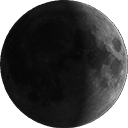
This graphic shows a gap in a protoplanetary disk of dust and gas whirling around the nearby red dwarf star TW Hydrae, which resides 176 light-years away in the constellation Hydra, sometimes called the Sea Serpent. The gap’s presence is best explained as due to the effects of a growing, unseen planet that is gravitationally sweeping up material and carving out a lane in the disk, like a snow plow. In the left image, astronomers used a masking device on the Hubble Space Telescope’s Near Infrared Camera and Multi-Object Spectrometer to block out the star’s bright light so that the disk’s structure could be seen. The Hubble observations reveal that the gap, which is 1.9 billion miles wide, is not completely cleared out. The illustration at right shows the gap relative to the star. The Hubble observations were taken on June 17, 2005.
Credit: NASA, ESA, J. Debes (STScI), H. Jang-Condell (University of Wyoming), A. Weinberger (Carnegie Institution of Washington), A. Roberge (Goddard Space Flight Center), G. Schneider (University of Arizona/Steward Observatory), and A. Feild (STScI/AURA)
Astronomers using NASA’s Hubble Space Telescope have found compelling evidence of a planet forming 7.5 billion miles away from its star, a finding that may challenge current theories about planet formation.
Of the almost 900 planets outside our solar system that have been confirmed to date, this is the first to be found at such a great distance from its star. The suspected planet is orbiting the diminutive red dwarf TW Hydrae, a popular astronomy target located 176 light-years away from Earth in the constellation Hydra the Sea Serpent.
Hubble’s keen vision detected a mysterious gap in a vast protoplanetary disk of gas and dust swirling around TW Hydrae. The gap is 1.9 billion miles wide and the disk is 41 billion miles wide. The gap’s presence likely was caused by a growing, unseen planet that is gravitationally sweeping up material and carving out a lane in the disk, like a snow plow.
The planet is estimated to be relatively small, at 6 to 28 times more massive than Earth. Its wide orbit means it is moving slowly around its host star. If the suspected planet were orbiting in our solar system, it would be roughly twice Pluto’s distance from the sun.
via NASA – NASA’s Hubble Uncovers Evidence of Farthest Planet Forming From its Star.

